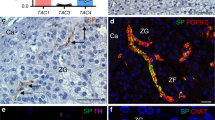Abstract
Preproadrenomedullin is processed into at least two biologically active peptides, adrenomedullin (AM) and proadrenomedullin N-terminal 20 peptide (PAMP). Both peptides are hypotensive; however, they exert this action via differing mechanisms. In pituitary cells in culture, both basal and releasing factor-stimulated adrenocorticotropin (ACTH) secretion is inhibited by AM. Here we report that basal, but not stimulated, ACTH secretion from cultured rat pituitary cells is also inhibited by PAMP. The effect is dose-related, occurs in a physiologically relevant dose range that is similar to that of AM, and is blocked by the potassium channel blocker, glybenclamide. The failure of glybenclamide to inhibit AM’s effects on ACTH secretion indicates that in pituitary, as in other tissues, these two products of the same prohormone can exert similar biologic activity, although via differing mechanisms.
Similar content being viewed by others
References
Kitamura, K., Sakata, J., Kangawa, K., Kojima, H., Matsuo, H., and Eto, T. (1993). Biochem. Biophys. Res. Commun. 194, 720–725.
Ishimitsu, T., Kojima, M., Hino, J., Matsuoka, H., Kitamura, K., Eto, T., et al. (1994). Biochem. Biophys. Res. Commun. 203, 631–639.
Feng, C. J., Kang, B., Kaye, A. D., Kadowitz, P. J., and Nossman, B. D. (1994). Life Sci. 55, 433–438.
Hirata, Y., Hayakawa, H., Suzuki, Y., Suzuki, Y., Ikenouchi, H., Kohmoto, O., Kimura, K., et al. (1995). Hypertension 25, 790–795.
Shimosawa, T., Ito, Y., Ando, K., Kitamura, K., Kangawa, K., and Fujita, T. (1995). J. Clin. Invest. 96, 1672–1676.
Andreis, P. G., Neri, G., Prayer-Galetti, T., Rossi, G. P., Gottardo, G., Malendowicz, L. K., et al. (1997). J. Clin. Endocrinol. Metab. 82, 1167–1170.
Andreis, P. G., Mazzocchi, G., Rebuffat, P., and Nussdorfer, G. G. (1997). Life Sci. 60, 1693–1697.
Yamaguchi, T., Baba, K., Doi, Y., Yano, K., Kitamura, K., and Eto, T. (1996). Hypertension 28, 308–314.
Ebara, T., Mura, K., Okumura, M., Matsuura, T., Kim, S., Yukimura, T., et al. (1994) Eur. J. Pharmacol. 263, 69–73.
Murphy, T. C. and Samson, W. K. (1995). Endocrinology 136, 2459–2463.
Samson, W. K. and Murphy, T. C. (1996). Endocrinology 138, 613–616.
Katoh, F., Kitamura, K., Niina, H., Yamamoto, R., Washimine, H., Kangawa, K., et al. (1995). J. Neurochem. 64, 459–461.
Takano, K., Yamashita, N., and Fujita, T. (1996). J. Clin. Invest. 98, 14–17.
Samson, W. K., Murphy, T. C., and Schell, D. A. (1995). Endocrinology 136, 2349–2352.
Kapas, S., Catt, K. J., and Clark, A. J. L. (1995). J. Biol. Chem. 270, 25,344–25,347.
Takahashi, K., Satoh, F., Sone, M., Murakami, O., Sasano, H., Mouri, T., et al. (1997). Peptides 18, 1051–1053.
Sakata, J., Shimokubo, T., Kitamura, K., Nakamura, S., Kangawa, K., Matsuo, H., et al. (1994). FEBS Lett. 352, 105–108.
Wang, X. and Greer, M. A. (1994). Mol. Cell. Endocrinol. 109, 11–18.
Lang, M. G., Paterno, R., Faraci, F. M., and Heistad, D. D. (1997). Stroke 28, 181–185.
Quast, U. and Cook, N. S. (1989). J. Pharmacol. Exp. Ther. 250, 261–271.
Parkes, D. G. and May, C. N. (1995). J. Neuroendocrinol. 7, 923–929.
Karschin, C., Schreibmayer, W., Dascal, N., Lester, H., Davidson, N., and Karschin, A. (1994). FEBS Lett. 348, 139–144.
Wang, X., Inukai, T., Greer, M. A., and Greer, S. E. (1994). Brain Res. 662, 83–87.
Samson, W. K. (1997). In: Endocrinology, Basic and Clinical Principles, Conn, P. M. and Melmed, S. (eds.). Humana Press: Totowa, NJ.
Samson, W. K., Said, S. I., Snyder, G. D., and McCann, S. M. (1979). Peptides 1, 325–332.
Author information
Authors and Affiliations
Corresponding author
Rights and permissions
About this article
Cite this article
Samson, W.K., Murphy, T.C. & Resch, Z.T. Proadrenomedullin N-terminal 20 peptide inhibits adrenocorticotropin secretion from cultured pituitary cells, possibly via activation of a potassium channel. Endocr 9, 269–272 (1998). https://doi.org/10.1385/ENDO:9:3:269
Received:
Revised:
Accepted:
Issue Date:
DOI: https://doi.org/10.1385/ENDO:9:3:269




